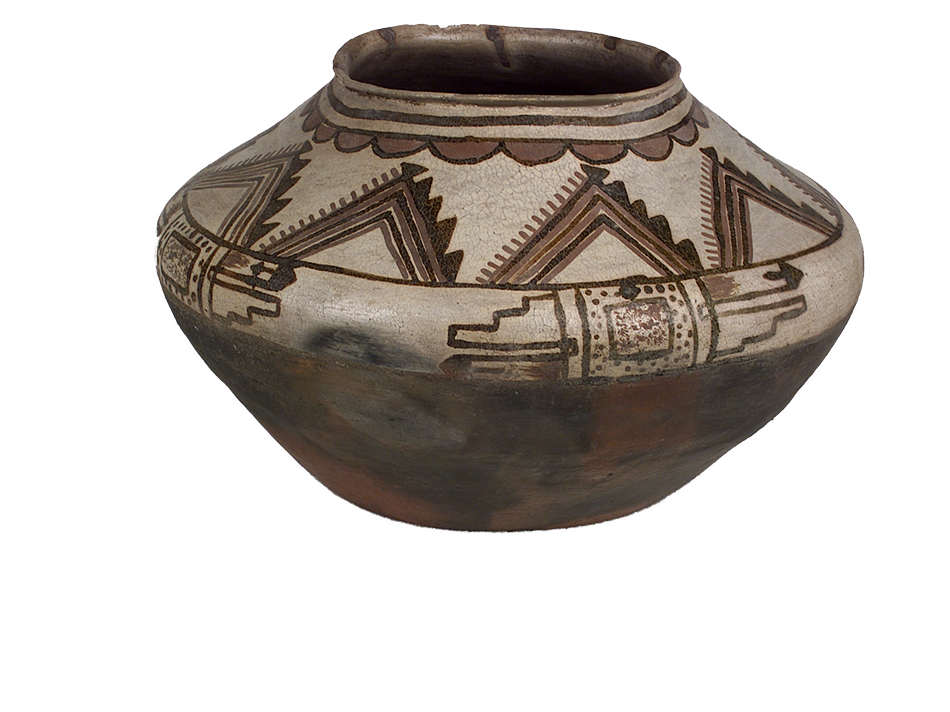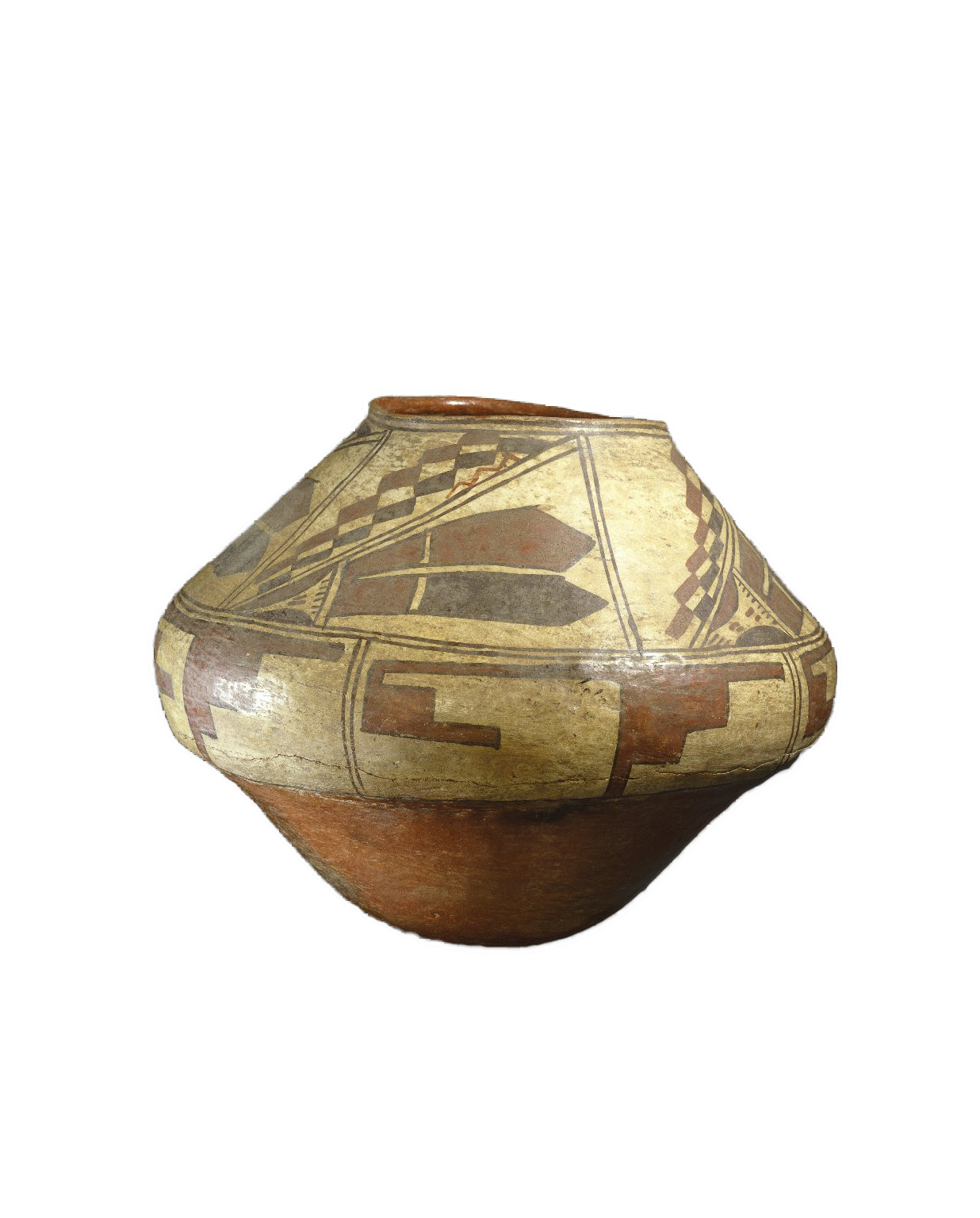Background
In 1680 the Northern Tiwa, Tewa, Towa, Tano, Keres, Pecos, Zuni, and Hopi communities united and killed 400 Spanish colonizers and drove the remaining 2,000 off their lands. This uprising is now known as the Pueblo Revolt. The Pueblo Revolt was so successful that it forced the Spanish colonial government to abandon the province they called Santa Fe de Nuevo México. It took the Spanish over a decade to regroup and reclaim the territory.
About the Artifacts
The Pueblo Revolt was not just an armed uprising. The participating Indigenous communities also rejected Spanish influences and returned to pre-European contact traditions. This can be seen in the pottery created by Zuni women during and after the revolt. The first pot pictured above was made while the fighting occurred. The designs look hurried, misshapen, and simplistic, serving as visual representations of the women’s experiences of war during the revolt. But the symbols on the pot are traditional; the artist left out the crosses and other Catholic insignia that Spanish overseers demanded from Zuni craftswomen before the revolt. Thus, despite its imperfections, this pot represents the return to traditional practices that characterized the cultural side of the Pueblo Revolt and its clear defiance of Spanish influence.
The second water jug was made after the Pueblo Revolt ended. It tells the story of a healing community. The asymmetrical design is covered in clean, crisp lines, which indicates that the artist had time to perfect her work. The red, black, and brown pigments take time and effort to produce, another indication that this jug was made in an era of peace and stability. The patterns on the pot incorporate even more traditional Zuni designs and symbols, like the brown and black feather motif. This shows that Zuni artists continued to explore and honor their cultural traditions even after the initial crisis of the revolt was over.
Vocabulary
- Catholic: A Christian who follows the pope in Rome.
- Hopi: One of the communities of people who lived in the American Southwest prior to European contact. Today there is a Hopi community in northeastern Arizona.
- Keres: One of the communities of people who lived in the American Southwest prior to European contact. Today there is a Keres community in Central New Mexico.
- Northern Tiwa: One of the communities of people who lived in the American Southwest prior to European contact. Today there is a Northern Tiwa community in Northern New Mexico.
- Pecos: One of the communities of people who lived in the American Southwest prior to European contact. Today there is a Pecos community in Western New Mexico.
- Pueblo Revolt: The 1680 uprising of Indigenous people in the American Southwest against Spanish colonizers.
- Tano: One of the communities of people who lived in the American Southwest prior to European contact. Today there is a Tano community in pueblos along the Rio Grande.
- Tewa: One of the communities of people who lived in the American Southwest prior to European contact. Today there are Tewa communities in Central New Mexico and Northeastern Arizona.
- Towa: One of the communities of people who lived in the American Southwest prior to European contact. Today there is a Towa community outside Albuquerque, New Mexico.
- Zuni: One of the communities of people who lived in the American Southwest prior to European contact. Today there is a Zuni community in Western New Mexico
Discussion Questions
- What differences do you notice between these two pots? What can we infer from these differences?
- What do these pots reveal about how women understood the Pueblo Revolt of 1680?
- Why is the study of material culture important in studying the history of Indigenous people? Why is this approach to studying the past challenging?
Suggested Activities
- APUSH Connection: 2.5 Interactions Between American Indians and Europeans
- Include these images in a lesson about Indigenous resistance to colonization. How did Zuni artists stand up against colonization?
- Use these objects to introduce your students to the basic practices of artifact analysis. What details do they notice on the pots? What information can be inferred from those details? What can we learn by comparing objects from different eras of Zuni history?
- Combine these objects with Life Story: The Gateras of Quito for a lesson about the ways Indigenous women resisted and adapted to Spanish colonial government.
- For a lesson on the labor of women in Indigenous communities, combine this resource with any of the following:
- Indigenous people across North and South America had a variety of responses to the arrival of European colonizers. Combine the Zuni pots with any of the resources below, and ask the students to write about the differences in each woman’s engagement with European colonizers and the outcomes they achieved:
- Explore the artistic process used to make Pueblo pottery through the making of coil-construction clay pots, and discover the skills needed to create a pot that considers aesthetics, function, and tradition. Students may also reflect on the art-making process and consider how it might have felt for Zuni women to construct these pots during a time of uprising and revolution.
Themes
POWER AND POLITICS








